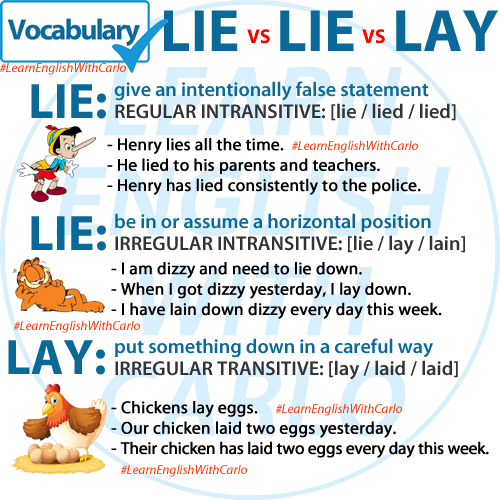
English can be tricky, especially when it comes to words that sound the same but have different meanings and uses. A common source of confusion is the difference between “lie,” “lie,” and “lay.” These three words are often mixed up, but understanding their meanings and how they are used can help you use them correctly. Let’s break it down:
1. LIE (to give an intentionally false statement)
- Meaning: This “lie” is used when someone says something untrue on purpose.
- Type of Verb: Regular Intransitive (It doesn’t take a direct object)
- Forms: lie / lied / lied
Examples:
- Present: Henry lies all the time.
- Past: He lied to his parents and teachers.
- Present Perfect: Henry has lied consistently to the police.
Tip: If you’re talking about telling an untruth, this is the “lie” you want to use.
2. LIE (to be in or assume a horizontal position)
- Meaning: This “lie” refers to the act of being in a flat position, usually on a surface like a bed or the ground.
- Type of Verb: Irregular Intransitive (It doesn’t take a direct object)
- Forms: lie / lay / lain
Examples:
- Present: I am dizzy and need to lie down.
- Past: When I got dizzy yesterday, I lay down.
- Present Perfect: I have lain down dizzy every day this week.
Tip: Think of this “lie” when you’re talking about resting, reclining, or being in a flat position.
3. LAY (to put something down carefully)
- Meaning: This verb is used when you are placing something down gently or with care.
- Type of Verb: Irregular Transitive (It requires a direct object)
- Forms: lay / laid / laid
Examples:
- Present: Chickens lay eggs.
- Past: Our chicken laid two eggs yesterday.
- Present Perfect: Their chicken has laid two eggs every day this week.
Tip: Use “lay” when you’re talking about placing something down. Remember, this verb always needs a direct object – something that is being laid down.
How to Remember the Differences:
- Lie (untruth) – Focuses on something false. Think: “Tell a lie.”
- Lie (recline) – Focuses on resting or reclining. Think: “Lie down.”
- Lay (place) – Focuses on placing something. Think: “Lay an object down.”
Quick Reference Table
| Verb | Meaning | Type | Forms | Example Sentence |
|---|---|---|---|---|
| Lie (1) | To say something untrue | Regular Intransitive | lie / lied / lied | “He lied to his parents.” |
| Lie (2) | To recline or rest | Irregular Intransitive | lie / lay / lain | “I lay down yesterday.” |
| Lay | To place something down | Irregular Transitive | lay / laid / laid | “She laid the book on the table.” |
